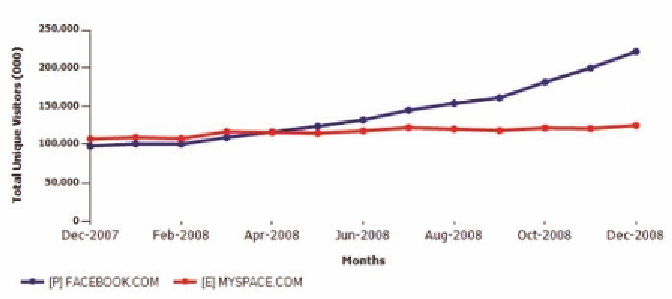Information Technology Reference
In-Depth Information
Figure 1. Trendline of unique visitors to Facebook versus MySpace (Source McCarthy (2009))
(Raskin, 2006). The most predominant social
networking sites include MySpace, Facebook,
Friendster, YouTube, Blog-it, Mig33 and Xanga.
Mxit, a South African initiative, features amongst
the most popular mobile-driven social networking
platforms. These sites are, in different forms, social
utilities that connect people through the ability to
share information such as messages, photographs
and personal characteristics and preferences.
As of mid 2009, Facebook alone had over 300
million users worldwide, a four-fold increase
within a single calendar year (Wikipedia, 2009).
MySpace.com, now owned by News Corporation,
launched as a website to help unknown musicians
reach greater audiences. It soon progressed into a
virtual community of over 84 million users who
post profile pages detailing their life in words,
pictures and music (Wolfe, 2006). It is presently
rumoured to have around 110 million users and is
the dominant player in the United States market
(McCarthy, 2009). Both Facebook and MySpace
allow members to interact socially, building a
network of friends as well as friends of friends
with whom they share their thoughts, perceptions
and general life experiences (Raskin, 2006).
The graph below visually depicts traffic to
the two social networking stalwarts between
December 2007 and 2008, revealing that Face-
book appears to be winning in the share of total
unique visitors.
Marketers are increasingly faced with the
challenge of breaking through commercial clutter
in an attempt to capture the attention of over-
stimulated consumers, who are becoming more
and more adept at tuning out traditional forms of
advertising (Wolfe, 2006). With the extensive
adoption of online communication, many experts
believe social networking websites to have vast
potential as viral marketing platforms (i.e. tools
for spreading product information through WOM
communication). However, although evidence of
previous viral marketing success exists, little is
known about the attitudes, motivations and be-
haviours of those consumers who engage in social
networking, as well as which online promotion
and communication techniques best stimulate
viral marketing amongst social network users
(Phelps
et al
, 2004). The lack of knowledge in
this area may lead to the implementation of inef-
fective marketing, and requires further investiga-
tion in order to fully harness the potential of this
platform.
RESEARCH DESIGN
Both qualitative and quantitative research was em-
ployed for the empirical component of this study.
In terms of the former, experience interviews
were conducted with four individuals knowledge-

Search WWH ::

Custom Search